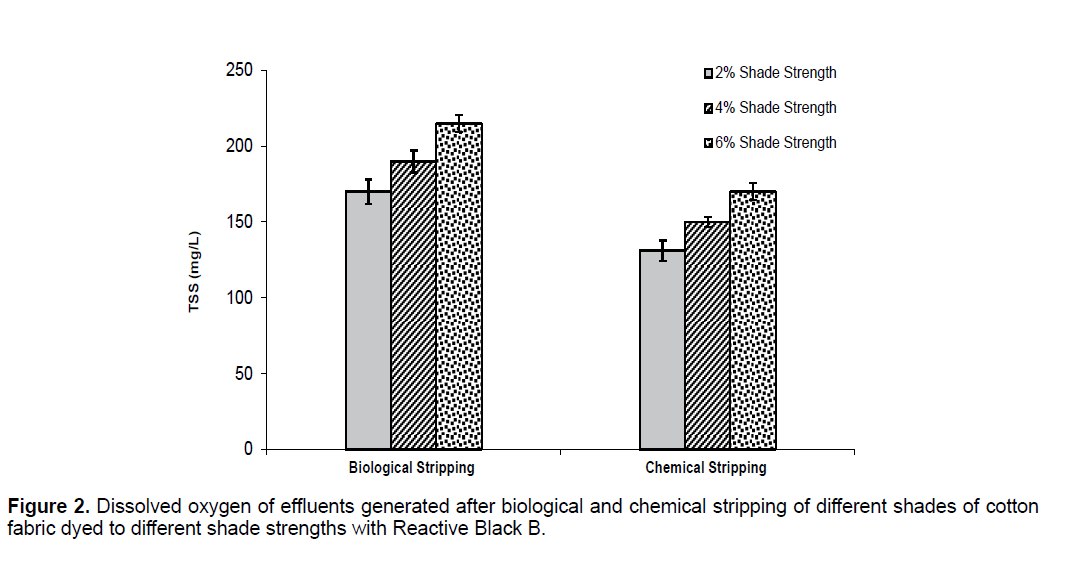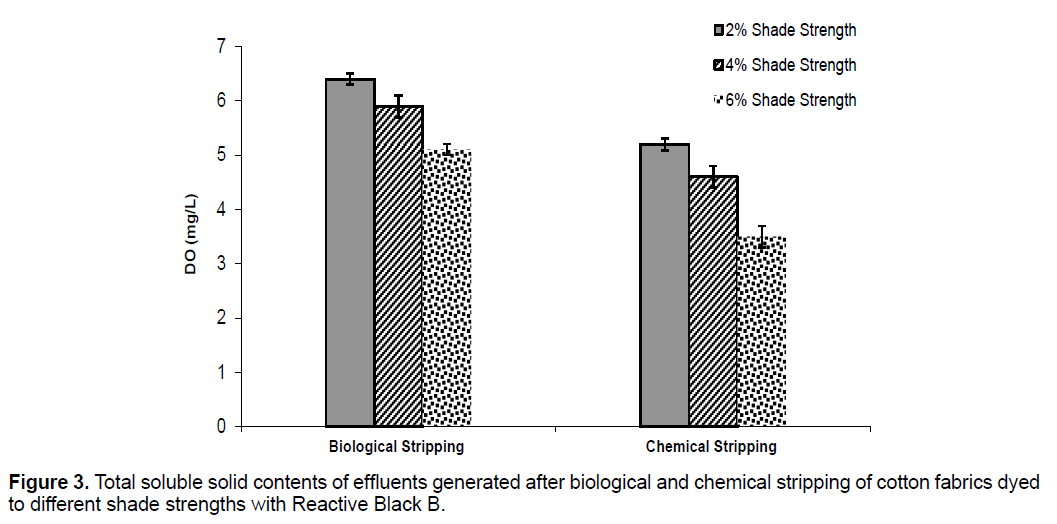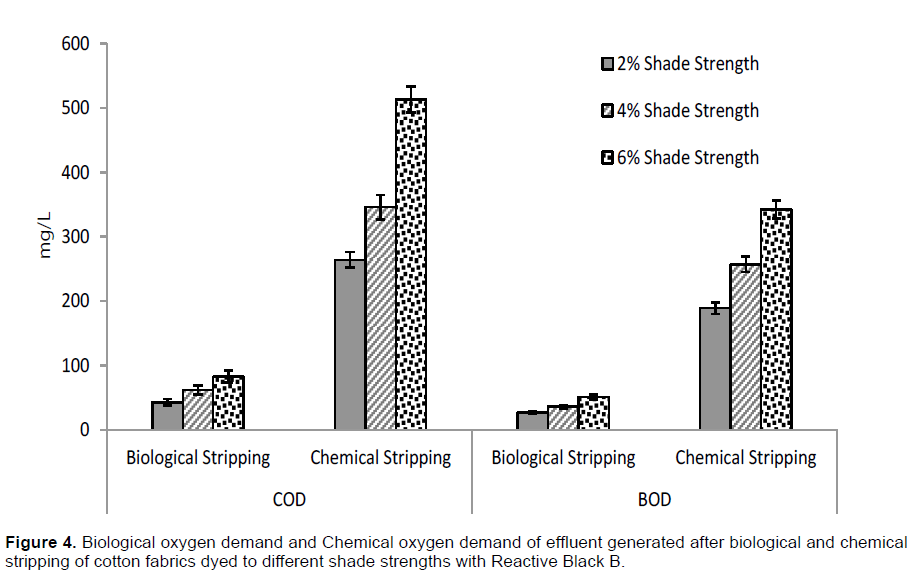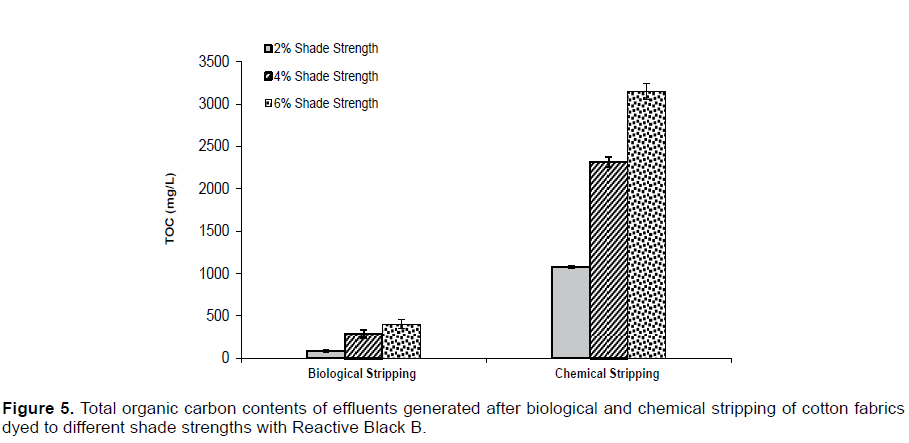A Novel Enzymatic Stripping of CI Reactive Black B Dyed Knitted Textiles Fabric as an Environmentally Responsible Technology
Shahzad Ali Shahid Chatha, Muhammad Asgher, Hafiz M.N. Iqbal Shaukat Ali
Shahzad Ali Shahid Chatha1, Muhammad Asgher1, Hafiz M.N. Iqbal2,*, Shaukat Ali1
1Industrial Biotechnology Laboratory, Department of Biochemistry, University of Agriculture Faisalabad, Pakistan;
2School of Engineering and Science, Tecnologico de Monterrey, Campus Monterrey, Ave. Eugenio Garza Sada 2501, Mexico.
- *Corresponding Author.
- Tel: +52-81-83582000; E-mail: hafiz.iqbal@my.westminster.ac.uk, hafiz.iqbal@itesm.mx
Received Date: April 09, 2016; Accepted Date: April 09, 2016; Published Date: April 09, 2016
Citation: Chatha SAS Ashger M, Iqbal HMN, et al. A Novel Enzymatic Stripping of CI Reactive Black B Dyed Knitted Textiles Fabric as an Environmentally Responsible Technology. Electronic J Biol, 12:3
Abstract
In the present study, we developed a novel ligninolytic enzymes based treatment for color stripping of cotton fabric. Knitted fabric was dyed with CI Reactive Black B dye to 2, 4 and 6% shades strengths. All the three shade were subjected to pre-optimized chemical and biological stripping processes, separately. In biological stripping, the fabrics were treated with ligninolytic enzymes extract produced from Ganoderma lucidum IBL-05 under optimum solid state fermentation conditions. The ligninolytic enzymes extract contained lignin peroxidase (944 ± 36.21 U/mL), manganese peroxidase (472 ± 12.11 U/mL) and laccase (94 ± 3.76 U/mL) as major enzyme activities. The effluents generated in the two processes were analyzed for various water quality parameters. The effluents from biological stripping were transparent whereas the dark blue colored effluents were generated in chemical stripping. The effluents generated in the chemical stripping process were highly polluted as compared to that obtained from the biological process in terms of pH, TSS, DO, BOD, COD and TOC values. Most of the water quality parameters of biological stripping effluents were in the recommended range of National Environment Quality Standards (NEQS) for industrial waste water, whereas, the values of these parameters were significantly higher for chemical stripping effluents suggesting that biological stripping is environment responsive technology for recycling of faulty dyed and old fabric.
https://bluecruiseturkey.co
https://bestbluecruises.com
https://marmarisboatcharter.com
https://bodrumboatcharter.com
https://fethiyeboatcharter.com
https://gocekboatcharter.com
https://ssplusyachting.com
Keywords
Dyed cotton fabric; Biological color stripping; G. lucidum IBL-05; Effluents analysis.
1. Introduction
In order to correct faulty dyeing or recycle the used fabrics, the fabrics are commonly stripped/decolorized using various chemical stripping techniques [1].
The traditional chemical stripping involves chemical reducing agents and stripping assistants used to enhance the stripping efficiency of the process [1,2]. These destructive chemical color stripping liquids used in textile industries hydrolyze the dye molecules that are released to water bodies in the form of industrial effluents. Chemical stripping liquids have inherent drawbacks as none of them could be used on various blends of fabrics and dyes and have to be designed individually, depending on the nature of the dye to be removed and the type of fabrics [3]. All of the chemical color removal processes are associated with generating a chemical waste stream that must be treated in an environmentally conscious manner before discharging into water bodies [4]. The stripping effluents contain dyes and dye intermediates that are mutagenic and carcinogenic [5,6]. Their discharge into the surface water also leads to aesthetic problems, obstructing light penetration and oxygen transfer into water bodies [7].
All dyes used in the textile industry are designed to resist fading upon exposure too many chemicals including oxidizing agents, and microbial attack and during textile processing, up to 15 percent of the used dyestuffs in the form of effluents are discharged into water bodies. In addition to their visual effect and their adverse impact in terms of chemical oxygen demand, some synthetic dyes cause allergy, dermatitis and skin irritation and they are toxic, mutagenic and carcinogenic in humans [8-11]. Dye-containing effluents are hardly decolorized by conventional biological wastewater treatments. Biotechnological approaches for the remediation of dye-contaminated textile effluents/xenobiotic compounds are receiving attention, worldwide and further development of biotreatment processes will be facilitated by identifying more efficient microorganisms and the ways to reduce the time and cost [4,11]. White Rot Fungi (WRF) are considered as better dye-degraders than prokaryotes because of their extracellular and non- specific lignin mineralization enzyme system that enables them to degrade a wide range of organic pollutants [12]. Due to environmental legislation and law enforcement, a lucrative and environmentfriendly method for the removal of dyes from fabrics without any treatment and disposal problems is an immense stipulate among the industrialists.
In our previous study, G. lucidum IBL-05 showed tremendous potential for decolorization/color stripping of cotton fabric dyed with Reactive Black B under the optimized set of conditions [1]. It was also noted that biological stripping technology is superior to chemical stripping in terms of percent color removal from cotton fabric dyed with Reactive Black B dye and stripped fabric quality. In continuation of above-mentioned studies and keeping in view the ever growing environmental concerns, the quality of effluents generated during the biological and chemical color stripping of cotton fabric, were collected and evaluated for comparison.
2. Materials and Methods
The analytical work was carried out in Color Chemistry Laboratory and Industrial Biotechnology Laboratory, Department of Chemistry and Biochemistry, University of Agriculture, Faisalabad, Faisalabad. All the chemicals and reagents of analytical grade were purchased from Sigma-Aldrich (St. Louis, MO, USA). CI Reactive Black B dye having appearance of black powder, Molecular weight 991.82 g/mol and purity >80%, was donated by Sandal Dyestuffs (Pvt.) Limited, Faisalabad, Pakistan. Knitted cotton fabric (single jersey, plain, yarn account 20 tex and weight 127 g/m2 dry relaxed) was purchased from local hosiery market, Jinnah Colony, Faisalabad, Pakistan.
Dyeing of cotton fabric
Before dying, the grey fabric was bleached using solution containing 50% H2O2 diluted to 20 g/L and a solution containing 50% NaOH (15 g/L) for half an hour at 50ºC. The fabric was dyed with C.I. Reactive Black B dye in three different shade strengths (2, 4 and 6%) on the basis of weight of fabric (OWF), following the exhaust dyeing method already published as part of our previous work [1].
Chemical and biological color stripping
The fabric dyed in three different shade strengths was subjected to color stripping following the previously established chemical and biological color stripping methods under pre-optimized conditions and already published as part of our previous work [1]. The optimum biological stripping medium was analyzed for activities of ligninolytic enzymes secreted by G. lucidum during dye removal from the fabric. After color stripping process, the biological stripping medium was analyzed for LiP, MnP and laccase enzymes involved in dye removal following the previously established assays as were followed in our previous work [1].
Analysis of stripping effluents
The effluents generated during chemical and biological color stripping of all shade strengths were collected in labeled sampling vials from each triplicate stripping process in three replicate (n=54). The quality of effluents was assessed by monitoring the pH (Inolab pH-720, Germany), DO (YSI-57, Dissolved Oxygen Meter), COD, BOD, TSS and TOC, following the previously established methods [13].
Statistical analysis
Effluents samples (n=54) for all the three shades individually stripped in three replicates in chemical and biological process were collected and analyzed in triplicate. The data values have been presented as a mean ± SD (standard deviation). Furthermore, the data obtained were analyzed using the Analysis of Variance (ANOVA) on statistical software Costat Computer Package (version 6.303, PMB 320, Monterey, CA, 93940, USA) using Microsoft Windows XP 2002.
3. Results and Discussion
The optimum stripping culture filtrates of G. lucidum contained 944 ± 36.21, 472 ± 12.11and 94 ± 3.76 U/mL LiP, MnP and laccase activities, respectively (Table 1). The effluents generated at the end of both biological and chemical stripping processes were analyzed for water quality assessment parameters like pH, total suspended solid (TSS), dissolved oxygen (DO), Biological Oxygen Demand (BOD), Chemical Oxygen Demand (COD), Total Organic Carbon (TOC). The results of analyses have been described and discussed under the following subheadings.
| LiP (U/mL) |
MnP (U/mL) |
Laccase (U/mL) |
|---|---|---|
| 944 ± 36.21 | 472 ± 12.11 | 94 ± 3.76 |
Table 1: Activities of ligninases produced during enzymatic color stripping of fabric dyed with CI Reactive Black B.
The pH of biological and chemical stripping effluents
The pH of effluents generated in the biological stripping of dyed cotton fabric was 7.0, 6.5 and 7.5 for 2, 4 and 6% shade strengths, respectively. The pH of effluents from all shade strengths was within the by NEQS recommended pH range for industrial wastewater. However, the pH values of control samples (un-inoculated incubated under the same set of conditions) were 5.0, 4.8, 6.0, respectively that were slightly lower than recommended limits. In the case of chemical stripping the effluents were more basic having pH values of 11.3, 11.2 and 11.5 for 2, 4 and 6% shade strengths, respectively (Figure 1).
However, pH values effluents of control samples for chemical stripping were within the recommended NEQS limits. The statistical analysis revealed significant (P ≤ 0.05) differences in pH of effluents generated from both stripping processes.
The initial pHs of biological stripping media were adjusted to the pH 4 (the optimum pH used). The biological stripping process increased the pH of effluents, possibly due to the secondary metabolites and degradation products of dye molecules. The very basic pH values of effluents generated in the chemical stripping process were the result of high amounts of alkali and sodium dithionite used in the chemical treatment. National Environment Quality Standards (NEQS) demonstrate that pH of the industrial waste water should be in the range of 6.0–9.0 to be discharged into water bodies. The higher pH values due to unused and hydrolyzed chemicals present in the chemical stripping effluents may impose detrimental effects to aquatic life when discharged into the water bodies. A number of scientists had worked on the biodegradation of textile dyes in water but no one has investigated the quality of water (pH) after enzymatic and chemical stripping to access the level of toxicity of and its detrimental impact on aquatic life. Therefore, no similar work is reported in the literature to be compared with the finding of this research.
Total suspended solids
As per recommendations of NEQS, the industrial wastewater to be discharged into sewage should have TSS less than 400 mg/L. The effluents generated in the biological stripping of dyed cotton fabric was found to contain lower amounts of TSS for all shade strengths (170 mg/L for 2%; 190 mg/L for 4% and 215 mg/L for 6% shade strengths) than the NEQS recommended limits. However, in the case of chemical stripping, the effluents contained lower levels of TSS (131, 150 and 170 mg/L, for 2%, 4% and 6% shade strengths, respectively. Statistical analysis showed significant (P ≤ 0.05) differences in TSS of effluents generated from the two stripping processes. Higher TSS values of biological stripping effluents were due to the formation of fungal mycelia. This problem can be tackled using the filtered enzyme extracts of fungi instead of using mass fungal culture in stripping medium. The use of enzymes will improve the water quality along with reducing the time of biological treatment of the dyed fabric. No such type of investigations is reported in the literature to compare with (Figure 2).
Dissolved oxygen
The data regarding the amounts of DO in various effluents generated from biological and chemical stripping have been displayed in Figure 3. The effluents generated in all the treatment and control processes had lower DO values than distilled water (10.45 mg/L). The effluents generated in biological stripping process, contained 6.4, 5.9 and 5.1 mg/L of DO for 2%, 4% and 6% shade strength of the dyed cotton fabric, respectively. Whereas DO values were 5.2, 4.6 and 3.5 mg/L in effluents generated from chemical stripping of 2%, 4%, and 6% strength, respectively. The DO in effluent generated in the biological stripping treatment was found to be significantly (P ≤ 0.05) higher than that of their chemical counterparts. The very low levels of DO of effluents generated in the chemical stripping process might be due to the higher processing temperature (70-80ºC) of the chemical treatment. Biological stripping is superior to chemical stripping because an adequate amount of DO is necessary for good quality water. If DO level of water drops below 5.0 mg/L, the aquatic life is under stress and the level below 1-2 mg/L even for a few hours can cause the death of large fish.
Biological oxygen demand
The Biological Oxygen Demand (BOD) is also a very important parameter to evaluate the quality of water. NEQS demonstrates that the BOD level of industrial wastewater should be lower than 250 mg/L to be discharged into sewage water stream. In the present study, the BOD levels of effluent generated in the biological stripping of dyed cotton fabric were 27, 36 and 51 mg/L for 2%, 4%, and 6% shade strengths, respectively. These values are quite lower than those recommended by NEQS for industrial wastewater. In the case of chemical stripping, the effluents were found to be very polluted having 180, 257, 342 mg/L BOD levels for 2%, 4% and 6% shade strengths of dyed cotton fabric, respectively (Figure 4). Statistical analysis showed the significant (P ≤ 0.05) differences in BOD of effluent generated during the two stripping processes. Overall, the BOD of effluents generated in the biological stripping process was many folds lower as compared to chemical stripping effluents. The high values of BOD of effluents produced during the chemical stripping process may reflect that the effluents may contain hydrolyzed organic dye molecules. On the other hand, the lower values of BOD of effluents generated in biological stripping are indicative of degradation and ultimately, the complete mineralization of dyes. The effluents generated during the chemical stripping process clearly demonstrate that this is not a healthy practice, implemented in the textile industries and the findings of our present research provide an alternate option.
Chemical oxygen demand
The COD levels of effluents produced in the biological stripping of dyed cotton fabric were 43, 62 and 83 mg/L for 2%, 4%, and 6% shade strengths, respectively. Whereas, in the case of chemical stripping the effluent were highly polluted having COD levels of 246, 346 and 513 mg/L for 2, 4 and 6% shade strengths of dyed cotton fabric, respectively (Figure 4). Chemical stripping effluents showed a high level of pollution when compared to 250 mg/L COD level recommended by NEQS (APHA, 1998). Biological stripping was superior to chemical stripping, especially for light shade strengths. Bioremediation of dye containing textile effluents is accompanied by COD reduction due to the degradation of the dyes and other chemical compounds present in the effluents [14,15]. The variations in the COD values in the dye containing effluents before and after treatment are directly or indirectly related to the mineralization of organic molecules as a function of dye removal [15]. The results of present research are very encouraging for the development of enzymatic color stripping process and its implementation in the textile industries as an alternate option to harsh chemical stripping process that not only deteriorates the quality of textile as well as is a life threat to aquatic livings and cause of certain detrimental diseases in human.
Total organic carbon contents of biological and chemical stripping effluents
The TOC contents in the effluents generated in biological stripping were found to be many folds lower than those from chemical stripping process (Figure 5). The effluents generated in biological color stripping contained 87.4, 289.2 and 400.4 mg/L of TOC contents for 2, 4 and 6% shade strengths of dyed cotton fabric, respectively. Whereas, the TOC contents in effluents generated from chemical stripping were 1075, 1036.4 and 3150.1 mg/L for 2, 4 and 6% shade strengths, respectively. The high level of TOC contents in the effluents of chemical treatment may be due to the presence of hydrolyzed dye molecules. Statistical analysis showed significant (P ≤ 0.05) differences in TOC contents of effluent generated in the two stripping processes. Decoloration of the dyestuffs by chemical treatment does not always result in their complete degradation to CO2 and H2O and some colorless reaction intermediates may be formed during degradation of dyestuffs. Therefore, it is important to measure the degree of degradation/ mineralization by estimating the Total Organic Carbon (TOC) removed after treatment [16]. The results of present study are favorable for the real practices of enzymatic color stripping process in the textile industries as alternate to chemical one to save the quality of water and aquatic life living in the water bodies in which textile effluents are discharged.
4. Conclusion
Overall, the effluents generated in the chemical stripping process were more polluted as compared to that of biological stripping process regarding water quality parameters like pH, TSS, DO, BOD, COD, and TOC. These findings strongly suggest that the biological stripping is superior color stripping process from dyed cotton fabric than the chemical stripping that can be recommended as an environmentally responsible approach to be implemented in textile processing industries after further investigating the textile aspects of this method. Enzymatic treatment of textile dyes and real dyes containing waste effluents could be of particular interest since it seems an ecofriendly approach to carrying out textile and various industrial waste treatment. More efficient ligninolytic enzymes can be developed using an advanced molecular approach that may be the economical and environment-friendly future catalysts for bioremediation process and can provide a potential breakthrough in the modern textile industry.
References
- Chatha SAS, Asgher M, Ali S, Hussain AI. (2012). Biological color stripping: a novel technology for removal of dye from cellulose fibers. Carbohydrate Polymers. 87: 1476-1481.
- ChathaSAS. (2011). Evaluation of microbial stripping of dyed cotton fabric. Ph.D. Thesis, University of Agriculture, Faisalabad, Pakistan.
- Fono A. (1980). US Patent No. 4,227,881. Washington, DC: U.S. Patent and Trademark Office.
- Asgher M, Yasmeen Q, Iqbal HMN. (2013). Enhanced decolorization of Solar brilliant red 80 textile dye by an indigenous white rot fungus Schizophyllum commune IBL-06. Saudi Journal of Biological Sciences. 20: 347-352.
- Ozturk A, Abdullah MI. (2006). Toxicological effect of indole and its azo dye derivatives on some microorganisms under aerobic conditions. Science of the Total Environment. 358: 137-142.
- De AragaoUmbuzeiro G, Freeman HS, Warren SH, et al. (2005). The contribution of azo dyes to the mutagenic activity of the Cristais River. Chemosphere. 60: 55-64.
- Bae JS, FreemanHS. (2007). Aquatic toxicity evaluation of new direct dyes to the Daphnia magna. Dyes and Pigments. 73: 81-85.
- Wesenberg D, Kyriakides I, Agathos SN. (2003). White-rot fungi and their enzymes for the treatment of industrial dye effluents. Biotechnology Advances. 22: 161-187.
- dos Santos AB, Cervantes FJ, van Lier JB. (2007). Review paper on current technologies for decolourisation of textile wastewaters: perspectives for anaerobic biotechnology. Bioresource Technology. 98: 2369-2385.
- Asgher M, Aslam B, Iqbal HMN. (2013). Novel catalytic and effluent decolorization functionalities of sol-gel immobilized Pleurotusostreatus IBL-02 manganese peroxidase produced from bio-processing of wheat straw. ChineseJournal of Catalysis. 34: 1756-1761.
- Asgher M, Iqbal HMN. (2013). Enhanced catalytic features of sol–gel immobilized MnP isolated from solid state culture of Pleurotusostreatus IBL-02. Chinese Chemical Letters. 24: 344-346.
- Asgher M, Shah SAH, Iqbal HMN. (2016). Statistical correlation between ligninolytic enzymes secretion and Remazol Brilliant Yellow-3GL dye degradation potential of Trametesversicolor IBL-04. Water Environment Research. 88: 338-345.
- Greenberg AE, Claesceri LS, Eaton AD. (1998). Standard methods for the examination of water and wastewater. American Public Health Association, Washington, DC.
- Gosetti F, Gianotti V, Angioi S, et al. (2004). Oxidative degradation of food dye E133 Brilliant Blue FCF: liquid chromatography–electrospray mass spectrometry identification of the degradation pathway. Journal of Chromatography A. 1054: 379-387.
- El-Rahim WMA, Moawad H. (2010). Testing the performance of small scale bioremediation unit designed for bioremoval/enzymatic biodegradation of textile azo dyes residues. New York Sci. J. 3: 77-92.
- Ay F, Catalkaya EC, Kargi F. (2009). A statistical experiment design approach for advanced oxidation of Direct Red azo-dye by photo-Fenton treatment. Journal of Hazardous Materials. 162: 230-236.

Open Access Journals
- Aquaculture & Veterinary Science
- Chemistry & Chemical Sciences
- Clinical Sciences
- Engineering
- General Science
- Genetics & Molecular Biology
- Health Care & Nursing
- Immunology & Microbiology
- Materials Science
- Mathematics & Physics
- Medical Sciences
- Neurology & Psychiatry
- Oncology & Cancer Science
- Pharmaceutical Sciences





